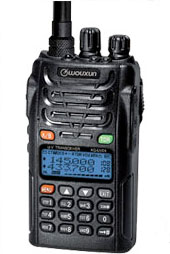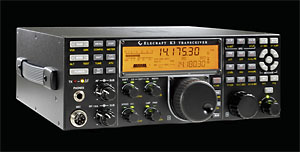Buying a new transceiver
So you have your shiny new licence in your hand and want to buy an amateur radio transceiver. Where do you start first?
The first thing is to decide what kind of radio you want. If you only want to talk to amateurs in your local area a 2m (144MHz) FM radio might suit your needs.
You can then choose between a handheld, a mobile or a base station radio transceiver (transmitter/receiver).
2m/70cms handheld
 A typical 2m handheld will let you have simplex QSOs (conversations) within perhaps a 5-10 mile radius. Use your local repeater and this gets boosted up to more than 20 miles, depending on where the repeater is relative to you plus your local terrain.
A typical 2m handheld will let you have simplex QSOs (conversations) within perhaps a 5-10 mile radius. Use your local repeater and this gets boosted up to more than 20 miles, depending on where the repeater is relative to you plus your local terrain.
Many areas have local “nets” (or regular conversations) on 2m that you can join in with, plus the GB2RS news service is broadcast on 2m as well in some areas – you need to check.
The upside of a 2m handy (as we call them) is that they are very portable. The downside is that without an external antenna your range may be a little limited. Also, battery life can be quite short – you may need to charge it every day. Nevertheless, 2m hand portables are good value for money and can offer a lot of enjoyment.
Many also offer dual-band capability, including the UHF 70cms (430MHz) band. For just a little more money you can then get access to two bands. Ranges on 70cms can be slightly less than 2m, but there are a lot of 70cms repeaters around the UK. It is best to ask a local radio amateur if they would recommend you buy a 70cms transceiver.
2m/70cms Mobile transceivers
These are designed to work in your vehicle and run off the 12V supply. Generally, they have a higher power output than a handheld (often up to 60 or so Watts, compared with handheld’s 5W) , although the power can usually be reduced if need be.
If using it in the car, the radio needs to be mounted securely and carefully wired in, perhaps straight to vehicle’s battery. You can use a mobile transceiver at home too, but you will need a dedicated 12V power supply, capable of supplying enough current, plus an antenna.
2m/70cms Base stations
You can buy a dedicated 2m/70cms base station. These are bigger and bulkier than a mobile unit, but often have the power supply built in. If you are serious about operating on the VHF/bands, perhaps on SSB as well, then they can be a good investment, although expect to pay a lot more than you would for a mobile.
HF transceiver
 If you want to talk to people around the world you will need to buy an HF transceiver. Typically, these transmit on all the amateur bands from 160m (1.8MHz) – 10m (28MHz), and often 6m (50MHz) too.
If you want to talk to people around the world you will need to buy an HF transceiver. Typically, these transmit on all the amateur bands from 160m (1.8MHz) – 10m (28MHz), and often 6m (50MHz) too.
There are one or two lightweight portable transceivers around for HF, typically running 5-10W. These can be ideal if you wish to operate portable outdoors. But if your budget will run to it you might want to consider a 100W-capable base-station transceiver.
Even if your licence doesn’t currently allow you to run 100W, a base station can be a good investment and you can usually reduce the power to the 10W or 50W maximum that you are allowed with your current licence. Who knows, you may upgrade your licence within a short period of time and want the extra power.
In addition to being able to transmit on all the HF amateur bands (and each one has different characteristics), you will also be able to use it for listening to other shortwave broadcasts from around the world, including broadcast stations, VOLMET (weather), aircraft, and much more.
As for which model to buy, your best bet is to visit an amateur radio equipment supplier, explain what you want to do with the radio and let them suggest a suitable transceiver.
Then, if possible, ask if you can try using the transceiver to see if you can get used to its controls and the way it works. This is important as we are all different and all have a different idea of what is good and bad. Failing that, see if a member of your local club can demonstrate his or her radio to you.
Other pages in this section – Setting up your shack:










